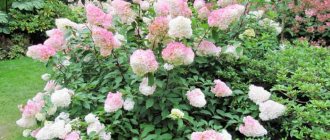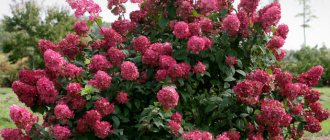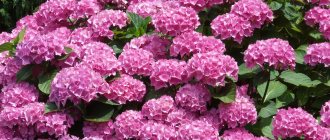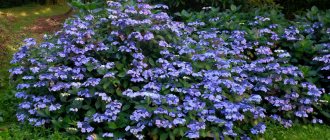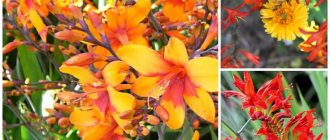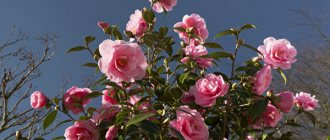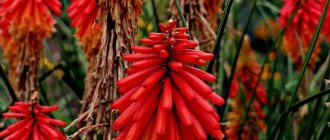- April 19, 2019
- Flowers
- Kristina Degtyareva
Paniculate hydrangeas have long gained popularity among gardeners around the world. Which is not surprising, because these shrubs look just great, and caring for them is not particularly difficult and does not take much time. The heroine of our article today is the delightful hydrangea paniculata Vanilla Fraze. Planting and care, biological description are presented below. Please note: this variety is quite in demand in the southern regions of our country, but experienced gardeners achieve excellent results even in the northern regions.
History of appearance
Vanilla Fraze was developed in France. The breeding was carried out by specialists from a nursery called Renault. The first work began back in 1989. The breeders were faced with a rather difficult task - they had to get a hydrangea that would quickly change its delicate white color to pink. As a result, several plants were obtained. But the final choice fell on Vanille Fraise hydrangea. This happened in 2003.
Biological description of hydrangea Vanilla Fries and photo
This name fully justifies the color scheme of the inflorescences - a combination of white and deep pink shades. The word fraise can be translated from French as “strawberry”. So what is Hydrangea paniculata Vanilla Fraze? The description is amazing: it is a spreading shrub with powerful and elastic shoots, the height of the plant on average reaches from one and a half to two meters. The shoots have a rich burgundy hue. Along the entire length of the branches there are neat oval leaves.
Hydrangea blooms begin in June and can continue until mid-November. The inflorescences are characterized by a pyramidal shape, each about 30 centimeters long. At the same time, initially the petals are white, but closer to August, hydrangea flowers become bright pink. At the beginning of autumn, the pink tone changes to burgundy-red. The plant blooms in the first year after planting in the ground.
Botanical description
Let's consider the description and characteristics of Hydrangea paniculata Vanilla Fraze, and analyze its features.
Table 1.1 – Brief characteristics of ornamental crops
| Characteristics | Peculiarities |
| Latin name for hybrid | Hydrangea paniculata Vanille Fraise |
| Height and width of the bush | Vanilla Fraze height is up to 150 cm, diameter is up to 200 cm. |
| Shoots, leaves | The branched branches are reddish in color and fall to the ground under the weight of the inflorescences. Velvety to the touch due to slight pubescence, the leaves have a dark green color. |
| Inflorescences, flowers | Flowers do not produce fruit. Blooming petals change their color from snow-white to pink, including all its shades. The inflorescences are pyramidal panicles. |
| Frost resistance of the hybrid variety | High, the plant can withstand temperatures down to –30°C. |
| The soil | Grow on slightly acidic, fertile and moist soils. |
| Illumination | The optimal planting location is illuminated, but can also be placed in light partial shade. |
| Trimming | Anti-aging pruning - at the end of autumn or before the start of sap flow. |
Now let’s take a closer look at the photo and description of Hydrangea paniculata Vanilla Fraze.
- In a beautifully flowering plant, a spherical shape is created in the process of blooming buds. The shoots of the tall bush themselves are straight, but flexible. Young and lignified branches are painted in a reddish or burgundy hue, which also gives the shrub a decorative appearance. Under the weight of the blossoming inflorescences, the shoots begin to bend towards the ground, which is what makes the bush round in shape;
- Rich green leaves densely dot the shoots. The leaf shape is oval, but there are also oblong leaves with a pronounced sharp tip. Thanks to the edge, the impression is created to the touch that the foliage has a velvet surface;
- An adult bush has a small root system, but is formed by a huge number of branching roots;
- Dense panicles-inflorescences are 35-45 cm long. Their shape is pyramidal or cone-shaped (this depends on the size of the inflorescence). The snow-white flowers on the panicle begin to bloom. And after just 2-3 weeks, the lower part of the inflorescence turns pinkish. After another 3 weeks, the flowers become a rich pink color, and in the fall we see open petals of a dark red tone. The smooth shading transition and pyramidal shape really are somewhat reminiscent of a strawberry ice cream cone.
Photo of hydrangea Vanilla Fraze in landscape design:
Flowering begins from the last week of June - the first ten days of July, and continues until October! For about 90-100 days, the garden is decorated with this unique shrub. If the inflorescences are not cut off in the fall, they will add decorative value to the bush in winter.
What other features of Vanille Fraise are there?
- The plant can reach its maximum height in 5 years, which is why experts classify it as a fast-growing ornamental crop;
- Flowering can be observed in the 1st year after planting the seedling;
- In terms of resistance to long-term and short-term decreases in temperature, this species of hydrangea is at the top of the list. Therefore, it is possible to grow the plant in open ground in all latitudes where frosts are within 30-34 °C;
- But gardeners also plant seedlings in more northern regions. To prevent bushes, even adults, from freezing, they are insulated before the cold snaps. This allows the shrubs to survive winter well and delight the gardener with blooming inflorescences in the summer.
Vanille Fraise is used by landscape specialists when arranging parks, gardens, summer cottages, and areas near the house. The ease of care and beauty of the bush have made this shrub a favorite of many gardeners. Conditions for planting seedlings
Where is the best place to plant Vanilla Fraze hydrangea? The plant does not have any special requirements for the growing location.
There are only nuances:
- When planting in a sunny area, it is undesirable for the bush to be illuminated by the rays of the sun all day. Therefore, they select places where there will be shade during the day. An excess of ultraviolet radiation often leads to the fact that the bush begins to develop worse;
- When planting in a small shade, it is important to regularly loosen the soil in the tree trunk area. Or, as an option, lay a layer of mulch in it;
- When growing, soil fertilized with organic matter should have a neutral or slightly acidic pH balance. The plant does not tolerate calcareous soils. In such areas, the death of young bushes is often observed.
Experts recommend planting Vanille Fraise in the middle latitudes of our country in the spring. Then the seedling has time to adapt to the new soil and weather conditions, which will allow it to form full-fledged roots and lateral roots before wintering in the open ground.
How to select and prepare seedlings?
- You can buy seedlings with buds that “sleep”. These are the ones you've seen in online nurseries. The product card with a photo and description of the Vanilla Fraze hydrangea variety states that the bushes are sent in plastic bags with a lump of earth. Such plants should be stored on the bottom shelf of the refrigerator before planting;
- It is recommended to purchase seedlings with shoots and leaves during the period when there are 2 weeks left before planting. But many gardeners order Vanilla Fraze online and often bring the hydrangea home long before this date. Therefore, until planting, the bushes are kept in a container in a cool place;
- If seedlings are purchased directly from a garden nursery or center, a visual inspection is carried out. The bush should be without visible damage, have several developed buds on the shoot, which may already bloom by the time of sale.
Hydrangea Vanille Fraise cannot be planted under trees and tall shrubs, as they strongly absorb moisture from the soil. The optimal planting option is an open area, protected from direct sun. If you ignore the advice of agronomists, the bush will grow at a slow pace, and the inflorescences will be small, barely reaching 10-15 cm.
Important! The selected place with fertile soil is loosened by 6–8 cm before planting the seedlings.
Let's look further at planting and caring for Hydrangea paniculata Vanilla Fraze.
Selection of seedlings
Have you decided to plant Vanilla Fraze hydrangea in your garden? Planting and care are very important stages, but there is something more important. This is the choice of seedling! It depends on which plant you choose how it will bloom and whether it will decorate your site. First of all, you should pay attention to the fact that seedlings on sale come with an open or closed root system. Of course, plants with bare roots are cheaper, but they take root less well. Hydrangea roots should be strong, free of damaged areas and mold.
Reviews from gardeners
Daria, 24 years old, Moscow region
I purchased Vanilla Fraze hydrangea for planting at the dacha. The shrub produces many pyramid-shaped inflorescences. The variety attracts with its unusual color scheme. The color scheme of the inflorescences changes from white to burgundy. Our bush is 2 years old, its height reaches 50 cm. 7-8 inflorescences bloom on it. Hydrangea endures winter without shelter. I water the bush every week, and every other day during drought. I additionally feed it with potassium nitrate.
Tamara, 38 years old, Lipetsk
A neighbor advised me to grow hydrangea a couple of years ago. The nursery really liked the variety Vanilla Fraze. I planted it in a sunny place under the window. The shrub blooms for 2-3 months. The petals first have a greenish tint, which changes to white and pink. Color saturation depends on the acidity of the soil. The plant is not afraid of spring frosts.
Natalya, 53 years old, Saratov
Hydrangea is one of the most beautiful shrubs on my site. The Vanilla Fraze variety is especially pleasing with the beauty of its flowering and unpretentiousness. For planting, I dug a hole into which I filled it with forest soil from under the pine tree. Fertile soil was poured on top. With this method of planting, you can do without acidifiers.
Choosing a place in the garden
In order for Vanilla Fraze to take root on the site and delight with lush flowering for a long time, it is important not only to select seedlings, but also to choose a suitable place. A number of factors should be taken into account: lighting, the presence of other bushes or trees nearby, the presence or absence of wind protection. The ideal option for this variety of hydrangea would be shaded areas, because bright sunlight slows down the growth of the plant and the inflorescences become small.
If your garden does not have a shady area, you can plant hydrangea in the sun, but it will be important to water it frequently and abundantly. Young plants need careful protection from the wind. For such purposes, any buildings, fences or low trees are suitable. You should not plant Vanilla Fraze hydrangea under trees, which absorb all the water. In the northern regions and the middle zone, gardeners recommend planting shoots on the south side.
How to cut and store dried flowers
Use dried hydrangea flowers to create a wreath or other home decorations:
- Trim the flower heads when the flowers are ripe.
- Remove leaves from stems and hang flower heads down in a warm, dry, dark, airy room.
- Once completely dry (usually a couple of weeks), store in a dry place away from direct sunlight.
- To improve the color of the flower, you can dye the inflorescences with diluted fabric dye.
Soil selection and preparation
Sandy soil is completely unsuitable for this hydrangea, because in it the plant will not receive the nutrients it needs in the required quantity. The best option is neutral soil, but slightly acidic soil is also suitable. If it is still sandy, peat and a large amount of humus should be added to it - this way the soil will retain moisture. Coniferous litter should also be added to any soil. But it is not recommended to use lime, chalk, or ash.
Hydrangea Vanilla Fraze: description of the planting process
Experts recommend planting paniculate hydrangeas of any variety before sap flow begins, in the spring. Autumn planting is also allowed - after leaf fall, but before frost begins.
Boarding order:
- You need to choose a suitable location. A few weeks before planting the shoots, dig a hole, the diameter of which should be 30 centimeters. If you plan to plant several shrubs, maintain a distance of about 1.5–2 meters between them.
- Prepare a special substrate for Vanilla Fraze hydrangea - combine two parts of turf soil and peat with one part of compost and the same amount of sand. Add superphosphate (one plant will need 50 grams) and potassium sulfate (30 grams). To deoxidize the soil, you should add fallen pine needles to it.
- The next stage is pouring the substrate into the hole.
- After one and a half to two weeks, when the soil has settled a little, you can plant hydrangea. The roots of the seedling should be trimmed and then dipped in any growth stimulator for two hours.
- Hydrangea Vanilla Fraze is ready to plant. Place it in the hole, straighten the roots thoroughly and carefully cover it with soil. Water the plant immediately after this.
Landing algorithm
The optimal time for planting hydrangea is late spring. Focus on warming the earth. In the south, the plant can be planted in the fall, before the first frost occurs. To do this, it is better to choose a penumbra zone. Under the influence of direct ultraviolet rays, the bush will develop very slowly, and a lack of lighting will cause the leaves and flowers to be pale and small.
The best option is if the plant is located in the shade before lunch, and in the light for the remaining time.
When choosing a location, climatic conditions are taken into account. In the south, the plant is recommended to be grown in areas that are covered with shade until lunchtime. In the north, on the contrary, it will develop well in open sunny areas. Fruit trees should not grow next to ornamental shrubs.
Step-by-step instructions:
- Dig a hole at least 50 cm deep and 30 cm in diameter. If you plant two or more shrubs, you must maintain an interval of at least 1 m between them.
- Place a drainage layer at the bottom of the dug hole, which will prevent stagnation of water and rotting of the roots. To do this, use crushed brick or expanded clay, having previously mixed them with sand.
- Pour out the prepared soil. You can use a ready-made soil mixture, or prepare it by mixing peat and turf soil in equal quantities. River sand and humus are added for water and breathability. The soil must be prepared at least 2 weeks before planting.
- Add potassium and phosphorus fertilizers to the holes.
- Sprinkle generously with water.
- Before planting, cut the seedlings: trim the root system and leave no more than 3 buds on the shoots.
- Carefully place the bush in the prepared hole, straightening the roots. Make sure that the neck remains on the surface.
- Fill the hole with earth, water the planted bush, loosen the soil around it and mulch the tree trunk with sawdust or pine litter.
Watering
Like any paniculate hydrangeas, Vanilla Fraze is moisture-loving, and therefore watering should not be skipped. It is recommended to moisten the soil under the bush at least once a week, but this can be done more often if the soil dries out and a hard crust forms on the surface. About ten liters of water need to be poured under one plant. It should be warm and settled. Please note: the root system of hydrangeas is located too close to the surface, and therefore when watering you should make sure that they are not exposed. Immediately after watering, procedures such as loosening and hilling should be carried out. Before a prolonged drought, it is recommended to mulch the soil with humus or peat.
Hydrangea care
Regular care ensures the formation of lush inflorescences of the Vanilla Fraze variety. The shrub is cared for by watering and fertilizing. Pruning the shoots helps give the bush the desired shape. To protect against diseases and pests, special preparations or folk remedies are used.
Watering
Paniculata hydrangea is moisture-loving, so watering is an essential step in caring for it. The soil under the bush is moistened every week, preventing it from drying out and forming a crust on the surface.
Important! Up to 10 liters of water are added under the Vanilla Fries panicle hydrangea bush.
For irrigation, use only warm, settled water. During drought, the shrub is watered more often, up to 2-3 times a week.
The root system of hydrangea is located close to the surface of the earth. Therefore, when watering, make sure that its roots are not exposed. After adding moisture, loosen the soil and hill up the shrubs. Mulching the soil with peat or humus helps reduce the number of waterings.
Feeding
To form lush inflorescences of Vanilla Fraze hydrangea, a supply of nutrients is required. The shrub is fed with organic matter or mineral complexes. The best results are obtained by alternating different types of fertilizing.
Panicle hydrangea Vanilla Fries is fed according to the following scheme:
- in spring when the buds swell;
- when the first buds appear;
- during the period of mass flowering;
- in the fall in preparation for winter.
For the first feeding of the Vanilla Fraze variety, an organic fertilizer based on mullein is prepared. Organics are mixed with water in a ratio of 1:15. The resulting solution is watered at the roots of the bushes.
Summer treatments are performed using mineral complexes. The fertilizer is prepared independently by combining ammonium nitrate, superphosphate and potassium salt. Each substance is taken in an amount of 30 g, after which they are dissolved in water.
Ready-made mineral complexes in the form of dry granules and suspensions have been developed for hydrangea. This fertilizer must be dissolved in water, and then water the bushes at the root.
Autumn feeding of the Vanilla Fraze variety is carried out using superphosphate and potassium sulfate. 30 g of each substance is added to each bush. Fertilizers containing nitrogen should be abandoned in the fall so as not to cause increased shoot growth.
Trimming
By pruning, Vanilla Fraze hydrangeas are given the desired shape. The bushes are pruned in early spring before the sap flows. Be sure to remove dry and broken branches.
Each shoot is shortened to 6-8 buds. In total, 5-10 branches are enough per bush.
Advice! Pruning shoots at the root helps to rejuvenate old shrubs. Branches no longer than 10-15 cm are left above the surface.
In summer, Vanilla Fries hydrangea is not pruned. However, it is necessary to eliminate dry inflorescences, which leads to the formation of new buds.
Protection from diseases and pests
Hydrangea Vanilla Fraze can be seriously affected by fungal diseases. In cold, rainy weather, plants are susceptible to powdery mildew and various rots. The lesion covers the shoots and leaves of the bush.
To protect hydrangea from diseases, solutions based on fungicides are prepared. The drugs Fundazol, Fitosporin, Topaz have good medicinal properties. Preventive spraying is carried out in early spring and late autumn.
If there is a lack of nutrients, the Vanilla Fraze variety is susceptible to chlorosis. The disease is identified by yellow leaves that begin to curl and fall off. To combat the disease, the shrub is fed with a complex fertilizer containing iron.
Attention! Paniculata hydrangea attracts pests: snails, aphids, spider mites. All of them feed on plant sap, as a result of which the leaves dry out and fall off, and the development of the bush slows down.
For insects, the bush is sprayed with solutions using insecticides Tanrek or Akarin. Folk remedies are suitable for prevention: infusions of onion peels or garlic. They are used for processing at any stage of bush development.
Shelter for the winter
Hydrangea Vanilla Fries can withstand harsh winters. When grown in the southern regions and the middle zone, the shrub is not covered.
In cold, snowless winters, mulching the soil with peat or humus helps protect hydrangeas from freezing. The thickness of the mulch is from 20 to 30 cm.
Young plants must be covered for the winter with agricultural material or burlap. When snow falls, a snowdrift is thrown over the bushes for additional insulation.
Fertilizer application
What other procedures are important for shrubs after planting? Hydrangea Vanilla Fraze and its care cannot be imagined without feeding. Nutrients such as organics or mineral complexes are best. Gardeners recommend alternating different types of fertilizers. There is a scheme that should be followed when feeding paniculate hydrangeas:
- kidney swelling;
- the appearance of buds;
- mass flowering;
- preparation for cold weather.
The first feeding, which is carried out at a time when the hydrangea's buds are gaining strength, should be organic. For one part mullein you will need 15 parts water. This solution should be watered directly to the roots of the bushes.
For summer feeding, you should choose mineral complexes. You can purchase ready-made formulations or prepare the fertilizer yourself. This will require 30 grams of potassium salt, ammonium nitrate and superphosphate. The resulting mixture should be dissolved in water. In the fall, it is necessary to “pamper” the plant with potassium sulfate and superphosphate - 30 grams per bush. Please note: before winter you should not apply nitrogen-based fertilizers - otherwise the Vanilla Fraze hydrangea will begin to grow vigorously.
Propagation methods for the Vanille Fraise variety
The shoots remaining after pruning can be cut into cuttings; last year's branches and young growth are suitable. Each cutting will consist of a section of shoot 12-15 cm long with two paired buds and leaves. Prepare the soil for further deepening, in the meantime, send the cuttings to the rooting stimulator. After 2-3 hours, remove the cuttings from the water, remove the lower leaves on each of them, and shorten the upper leaves to 1/3. After planting in the soil, cover the pots with jars or bottles, remembering to ventilate them daily. In a month you will receive finished material, ready for transplanting into open ground.
If you are interested in growing Vanilla Frazee hydrangea from scratch, in order to experience the delights of planting and caring for the plant to the fullest, try growing a shrub from seeds. This is a long process, but there is nothing complicated about it. A full-fledged flowering bush will be ready in 3-4 years.
To obtain seedlings, you can also use the methods of dividing the bush and removing the shoot from the mother plant. Division is only advisable when moving the hydrangea to another place; in this case, prepare for a long recovery period. A cutting is a shoot buried next to the main bush. This is done like this: a shallow cut is made across the vine, which, when buried, is directed downwards - from here roots will begin to develop. The buried shoot is left until the next season; a year later in the fall, the young plant is separated from the mother bush, now it can be planted separately.
Trimming
Pruning is necessary in order to give the lush, spreading shrub a neat shape. This event should be carried out in early spring, before the process of sap flow begins. First of all, dry and damaged branches should be removed. The next stage is pruning each shoot.
Pruning will also help to rejuvenate an adult hydrangea - 5-7 branches, the height of which is about 10 centimeters, should be left above the surface of the ground. In summer, paniculate hydrangea should not be trimmed, but dry inflorescences must be removed so that new buds appear.
Protecting plants from pests and diseases
Hydrangea Vanilla Fraze is quite resistant to diseases and pests. One of the few dangers is fungal diseases. If the summer is rainy and cool, the shrub may be affected by rot and powdery mildew. To protect hydrangea, you should promptly treat it with solutions prepared on the basis of fungicides. Gardeners recommend paying attention to such preparations as Topaz, Fundazol, Fitosporin. Hydrangea can also get sick if it lacks nutrients. In such a situation, chlorosis may begin. Identifying the disease is quite simple: it is characterized by symptoms such as yellowing of leaves, their curling and falling. Fertilizers that contain iron will help fight chlorosis.
Vanilla Fraze can attract various pests that feed on the sap of the bush. So if your hydrangea begins to dry out, its leaves fall off, and its growth slows down, check to see if the plant is infected with spider mites or aphids. It is possible that the hydrangea was attacked by snails. What to do if you find pests? First of all, you should use insecticides. “Akarin” and “Tanrek” are perfect. As a preventative measure, experts recommend using folk remedies - infusions prepared with garlic or onion peels.
Preparing for winter
With proper care and preparation for cold weather, paniculate hydrangea of this variety can survive frosts down to -35 degrees! Therefore, in the southern zone, Vanilla Fraze does not need to be covered for the winter. Gardeners from central Russia or northern regions are recommended to protect the plant from freezing by mulching the soil. The thickness of humus or peat mulch should be at least 20 centimeters. In the first two years after planting, hydrangea should be covered with special agricultural material (burlap can be used instead). After snow falls, gardeners recommend throwing a small snowdrift over the bush in order to further insulate it.
Advantages and disadvantages of the Vanilla Fries variety
Advantages:
- abundant and long flowering from July to September;
- beautiful large flowers of calm color;
- resistance to low temperatures, no need to dig up shrubs for the winter;
- perennial cultivation;
- easy reproduction;
- unpretentiousness to the soil.
Flaws:
- frequent watering, especially in dry weather;
- mandatory bush formation.
Reproduction
There are two ways to propagate this delightful shrub. The first is cuttings. It should be carried out in the spring: you need to carefully cut off several shoots (of course, along with the buds), and then dip them in any growth stimulator. Immediately after this, the cuttings can be planted in a flowerbed, and after they take root, they can be planted in a permanent place. Another way is to use so-called layering. At the beginning of spring, the lower shoots should be cleared of leaves and secured to the ground, sprinkled with fertile soil. By autumn, the cuttings will have taken root, which means you can replant them.
